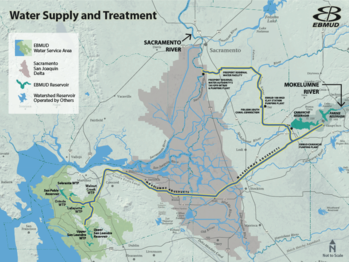
EBMUD Water Supply and Treatment Map
You may have noticed changes to the taste and smell of your tap water. These drought-related changes to our water supply operations are expected for the duration of the drought. New water sources and increased algae levels in our reservoirs and emergency supplies are causing changes to your tap water.
EBMUD tap water is safe to drink and use, and continues to meet all state and federal public health standards.
What is the reason for the change in my water?
During this Stage 4 drought, EBMUD has changed operations to ensure that people and businesses in the East Bay have a water supply if we face another dry year. In normal years, almost all of our water comes from the Mokelumne River. During this fourth year of drought, we are also bringing in water from the Sacramento River - a body of water with a different taste and smell profile than water from the Mokelumne River or water from local reservoirs to which customers are accustomed.
Earlier this spring, EBMUD changed its operations at Pardee Reservoir, switching to a higher intake valve where water is warmer and often has more algae than water sitting deeper in the reservoir. The operational change was necessary to preserve the reservoir’s coldest water for release downstream in the fall, per state and federal requirements, to improve river conditions for returning salmon. Algae are fully filtered out during water treatment but can leave behind taste and odor compounds.
Prolonged warm and sunny periods (which have been frequent during the drought) have created ideal conditions for algae growth in water reservoirs. Levels of algae in Pardee Reservoir, local East Bay reservoirs and the river systems we rely on are on the rise due to the drought. Local treatment plants, while able to filter out algae, may not be able to fully treat the taste and odor compounds algae leaves behind.
Is my tap water safe?
Yes. All tap water EBMUD delivers to customers meets or surpasses all state and federal public health standards. The most recent annual water quality report can be viewed at www.ebmud.com/wqr. To learn more about your drinking water, visit the Water Quality page.
Residential customers with questions or concerns should contact EBMUD at 1-866-403-2683 or email us at custsvc@ebmud.com.
Industrial and commercial customers should contact EBMUD for additional information relevant to their industrial processes.
How can I improve the taste and smell of my tap water?
Your tap water is safe to drink and use. Chilling tap water may improve the taste and smell. Boiling tap water is not necessary as your water is safe to drink.
Customers throughout the service area are likely to experience water with a different taste than they are accustomed to. Changes in operations will affect different areas at different times. We are doing our best to manage our system to prepare for another dry year, and ask for our customers to be patient with these changes.
How long will these changes last?
For the duration of the drought we can expect the characteristics of EBMUD water to be different than normal at different times in different communities. Algal blooms in a reservoir may last from a few days to weeks. EBMUD continuously tests at treatment plants and reservoir to ensure your tap water is always safe to drink and use.
How your tap water is treated
Water, no matter its source, is treated at one of five water treatment plants in the East Bay. Two of EBMUD’s treatment plants have aeration and ozonation processes to improve taste and odor.
 1. Source Water
1. Source Water
EBMUD draws water from the Mokelumne River, the Sacramento River, and also local runoff.
2. Coagulation
Coagulants are added to the water in basins. The coagulants help tiny particles of dirt and plant debris in the water to clump together by neutralizing the charge of the particles.
3. Flocculation
The water is mixed, causing sediment particles to combine. When the particles get large enough, they can settle to the bottom.
4. Sedimentation
The water is moved to another basin where it flows slowly to allow the sediment particles to settle to the bottom. This step removes about 85 percent of the particles from the water. Water for the next step is collected from the top of the sedimentation basins.
5. Ozonation
At Sobrante and Upper San Leandro water treatment plants, ozone is used to improve taste and reduce odors that occur occasionally due to algae blooms in the reservoirs that provide water to these plants. Ozone also helps disinfect water and control disinfection by-products that form when natural organics in water come into contact with chlorine, which is added in the final water treatment step.
6. Filtration
The almost-clear water from the sedimentation basins flows into deep, concrete-walled boxes. At the bottom are filter beds made up of layers of sand and anthracite. Any remaining particles are trapped in the anthracite and sand as the now-clean water flows down and through the rest of the filter bed into a collecting system.
7. Disinfection
The addition of chloramine, which combines low levels of diluted chlorine and ammonia, protects public health by killing any remaining microorganisms such as bacteria or viruses. As water leaves treatment plants it is chloraminated to ensure that the low level of disinfectant required by regulations remains in water as it is distributed to customers.
8. Distribution
Water is delivered to 1.4 million East Bay customers through a network of 4,200 miles of pipe.